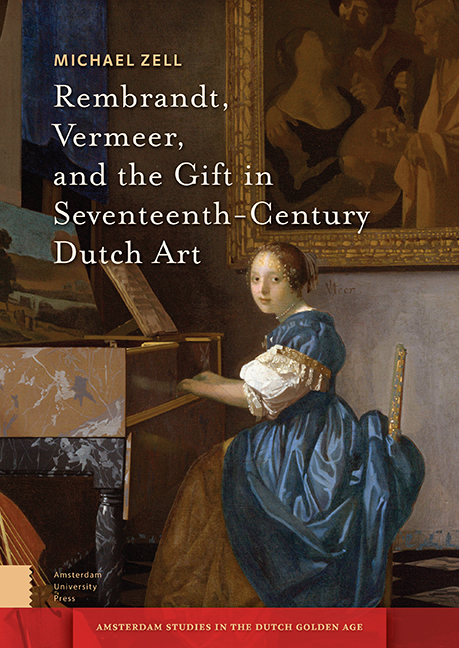Book contents
- Frontmatter
- Dedication
- Contents
- Illustrations
- Acknowledgments
- Introduction
- 1 The Gift and Art in Early Modernity
- 2 Art as Gift in the Dutch Republic
- 3 Rembrandt’s Art as Gift
- 4 Art and Leisure: Amateur Artists, Rembrandt, and Landscape Representation
- 5 For the Love of Art: Vermeer and the Poetics of the Gift
- Conclusion
- Bibliography
- Index
5 - For the Love of Art: Vermeer and the Poetics of the Gift
Published online by Cambridge University Press: 21 October 2021
- Frontmatter
- Dedication
- Contents
- Illustrations
- Acknowledgments
- Introduction
- 1 The Gift and Art in Early Modernity
- 2 Art as Gift in the Dutch Republic
- 3 Rembrandt’s Art as Gift
- 4 Art and Leisure: Amateur Artists, Rembrandt, and Landscape Representation
- 5 For the Love of Art: Vermeer and the Poetics of the Gift
- Conclusion
- Bibliography
- Index
Summary
Abstract
This chapter explores Vermeer's art in relation to the ethics and aesthetics of the gift. The gift culture of Dutch burgher society together with the conceptual framework of the gift paradigm cast new light on Vermeer's exceptionalism. Vermeer's depictions of beautiful women and refined courtship encourage the art lover to experience his paintings as if in love with their seductive beauty, figuring the ideal relationship between beholder and artwork, and painter and painting, in contemporary Dutch art theory. As objects of desire of the viewer and Vermeer himself, his paintings thematize art's inspiration in love, not the desire for fame or profit, laying claim to a gift-like status and carving out a symbolic space exempt from ordinary measures of value.
Keywords: Vermeer; Poetics of Painting; Women in Art; Art Theory; Mimesis; Gifts
The sophisticated representational effects of Vermeer's paintings assume a discriminating, specialized clientele of liefhebbers. These connoisseurs would have recognized that Vermeer's uniquely equivocal approach to the conventions of Dutch realist artifice set his pictures apart from their models in Gerard ter Borch's and Frans van Mieris's meticulously painted and fashionable Petrarchan images of beautiful women and dignified courtship. In contrast to the comparatively prolific Ter Borch and Van Mieris and most contemporaries, Vermeer's output was also remarkably limited, with an oeuvre consisting of only 36 extant paintings. This chapter maps the continuities between the rarefied conditions of Vermeer's practice, his novel paintings of Petrarchan poetic themes, and the discourse of the gift to clarify Vermeer's place within the Dutch artistic economy. Vermeer's adaptation of the modern Petrarchan subjects of beautiful women and gracious courtship invite the discerning male liefhebber to experience his work as if witnessing or entering into a courtship of a beautiful woman, figuring the ideal relationship between viewer and artwork, and painter and painting, of contemporary Dutch art theory. By analogizing the beholder's encounter with his work to the poetic structure of lover and unattainable beloved, Vermeer also aestheticized the desiring, possessive gaze of liefhebbers and himself to thematize his art's inspiration in love, not merely the desire for fame or profit. At once objects of the art lover's desire and products of Vermeer's own love of art, his paintings generate a symbolic social space defined through his culture's ethics of the gift as antithetical to economic relations.
- Type
- Chapter
- Information
- Publisher: Amsterdam University PressPrint publication year: 2021

